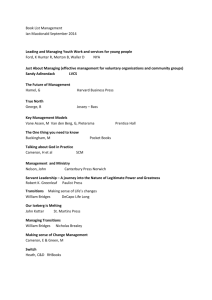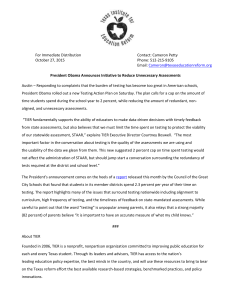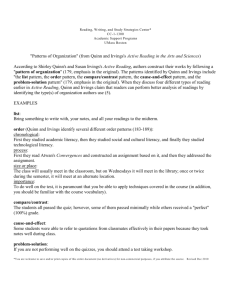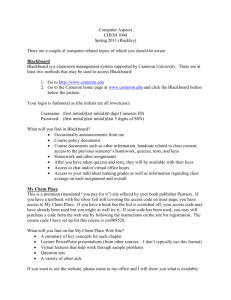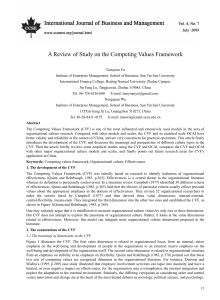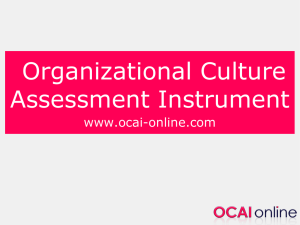white paper_Schaeffer - Talent Strategy Partners
advertisement
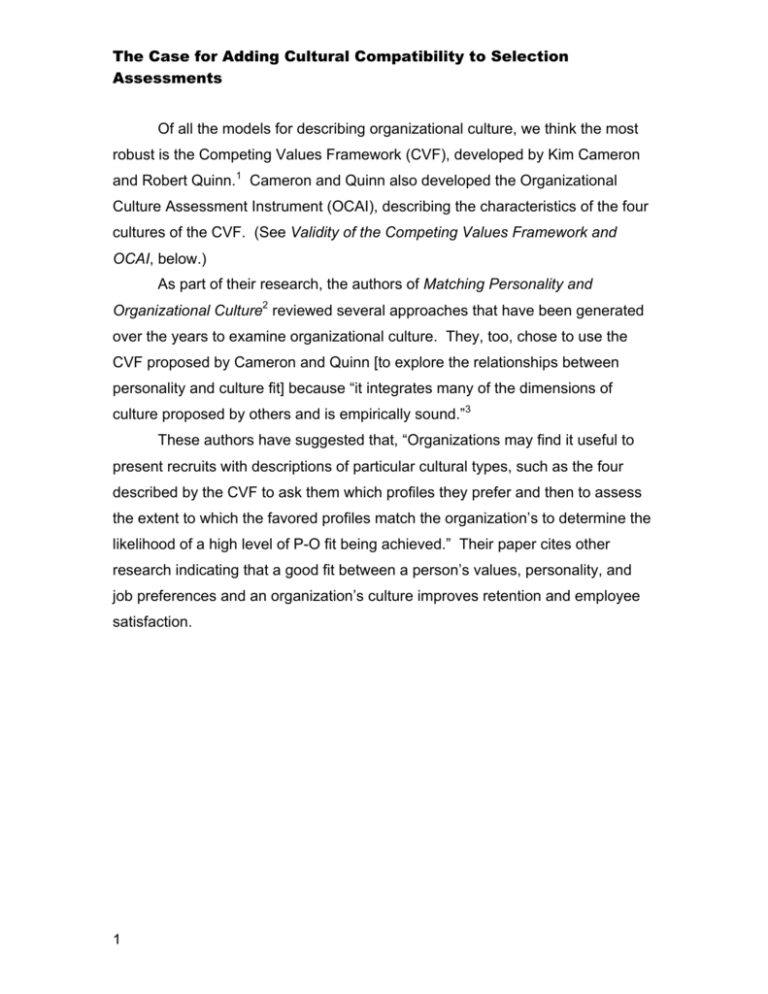
The Case for Adding Cultural Compatibility to Selection Assessments Of all the models for describing organizational culture, we think the most robust is the Competing Values Framework (CVF), developed by Kim Cameron and Robert Quinn.1 Cameron and Quinn also developed the Organizational Culture Assessment Instrument (OCAI), describing the characteristics of the four cultures of the CVF. (See Validity of the Competing Values Framework and OCAI, below.) As part of their research, the authors of Matching Personality and Organizational Culture2 reviewed several approaches that have been generated over the years to examine organizational culture. They, too, chose to use the CVF proposed by Cameron and Quinn [to explore the relationships between personality and culture fit] because “it integrates many of the dimensions of culture proposed by others and is empirically sound.”3 These authors have suggested that, “Organizations may find it useful to present recruits with descriptions of particular cultural types, such as the four described by the CVF to ask them which profiles they prefer and then to assess the extent to which the favored profiles match the organization’s to determine the likelihood of a high level of P-O fit being achieved.” Their paper cites other research indicating that a good fit between a person’s values, personality, and job preferences and an organization’s culture improves retention and employee satisfaction. 1 The Case for Adding Cultural Compatibility to Selection Assessments Culture Link™ Talent Strategy Partners has developed a methodology to Collabora've* match an individual’s Entrepreneurial* work environment preferences and work Organiza'onal*Culture* style with company Structured* culture. We call it Culture Link™ and it Results3driven* brings together the CVF and OCAI. With Culture Link, an applicant would be asked to complete a Candidate Preference Assessment documenting their preferences about the cultural characteristics described by the OCAI. At the same time, organization leaders would be asked to complete the Culture Engine™ (see below) survey in order to generate a culture profile based on the factors, as described in the CVF, that make the organization (or part of the organization) effective and drive execution of the business strategy. The Culture Link Candidate Preference Assessment is a self-assessment instrument that asks job candidates to identify their working style and state their preferences for a working environment. Their responses highlight the type(s) of culture in which they best fit and will be likely to thrive and succeed. Culture Engine, through a survey of a representative sampling of leaders, creates a profile of the organization’s current culture. It overcomes leaders’ perceptions of the culture, which are often quite different from the actual culture employees experience, by focusing primarily on strategic issues that impact organization effectiveness. An important caveat is that it may make little sense to try to describe the Lowe’s culture overall, as it is simply too large, heterogeneous, and complex an 2 The Case for Adding Cultural Compatibility to Selection Assessments organization. A better approach would be to divide the organization into separate “entities” – as examples, a store, a distribution center, all stores in a region, all distribution centers in a region, CSC. Then, respondents in each “entity” would complete the Culture Engine survey, creating a profile of the current culture within that entity. Respondents would be individuals in the entity who have a perspective of that entity’s unique goals and what makes that entity effective. Culture Engine™ Measuring culture has been a challenge because culture is not a tangible thing and culture in most organizations has not been articulated. This is unfortunate since research shows that companies with deliberate cultures that support the business strategy consistently outperform their competitors. We have built our practice on understanding the organization culture that will best support our clients’ strategy and helping to align talent management practices with that culture. In 2012, we developed Culture Engine in order to clearly define organizational culture. Culture Engine uses the CVF to look at culture through the lens of organization effectiveness. We have used it with many clients to develop profiles of current and desired culture (that is, the culture that will best support the business strategy) and diagnose the gaps between where there are today and where they need to be in the future. Most often, this has resulted in developing competency models to define the behaviors needed to move to the desired culture and ensure organization effectiveness. The competencies have been integrated into recruiting / selection, leadership and employee development, performance management, and succession planning. Validity of the CVF and OCAI4 The cultural construct we have found to be the easiest to understand and the best researched is the CVF. This framework was developed in the early 1980s as a result of studies of organizational effectiveness,5 followed by studies of culture, leadership, structure, and information processing.6 3 The Case for Adding Cultural Compatibility to Selection Assessments The framework consists of two dimensions (Figure 1), one that differentiates a focus on flexibility, discretion, and dynamism from a focus on stability, order, and control. Some organizations are effective if they are changing, adaptable, and organic, whereas other organizations are effective if they are stable, predictable, and mechanistic. This dimension ranges from organizational versatility and pliability on one end to organizational steadiness and durability on the other end. The second dimension differentiates a focus on an internal orientation, integration, and unity from a focus on an external orientation, differentiation, and rivalry. That is, some organizations are effective if they have harmonious internal characteristics, whereas others are effective if they focus on interacting or competing with others outside their boundaries. This dimension ranges from organizational cohesion and consonance on the one end to organizational separation and independence on the other. These dimensions have been found to represent what people value about an organization’s performance, what they define as good, right, and appropriate, how they process information, what fundamental human needs exist, and which core values are used for forming judgments and taking action.7 4 The Case for Adding Cultural Compatibility to Selection Assessments Flexibility and Discretion dynamism, changeability, adaptability, versatility, pliability External Focus and Differentiation rivalry, interacting or competing with others outside their boundaries, organizational separation, independence Internal Focus and Integration unity, internal harmony, organizational cohesion, consonance Stability and Control order, predictability, mechanization, organizational steadiness, durability Business results through culture™ 1 www.tsphr.com Figure 1 What is notable about these dimensions is that they represent opposite or competing assumptions. Each continuum highlights a core value that is opposite from the value on the other end of the continuum; that is, flexibility versus stability, internal versus external. The dimensions, therefore, produce quadrants that are also contradictory or competing on the diagonal. The upper left quadrant identifies values that emphasize an internal, organic focus, whereas the lower right quadrant identifies values that emphasize external, control focus. Similarly, the upper right quadrant identifies values that emphasize external, organic focus whereas the lower left quadrant emphasizes internal, control values. These competing or opposite values in each quadrant give rise the name for the model, the Competing Values Framework. Together these two dimensions form four quadrants, each representing a distinct type of organizational culture (Figure 2). 5 The Case for Adding Cultural Compatibility to Selection Assessments Flexibility and Discretion Collaborative Entrepreneurial The organization is a personal place; it’s like an extended family. The best leaders are warm, supportive and committed to employee development. Shared goals and values and a sense of “we-ness” permeate. The glue that holds the place together is loyalty and mutual trust. It’s generally accepted that empowerment and commitment, fostered by employee involvement and participation, is the key to organization success; that is, committed, satisfied employees produce effectiveness. The organization is a dynamic place where original ideas are generated and executed. The best leaders foster innovation and risk taking. People reconfigure themselves rapidly when new circumstances arise. Power flows from individual to individual or from task team to task team, depending on what opportunity is being addressed. The glue that holds the organization together is commitment to innovation and development. It’s generally accepted that organization effectiveness is driven by innovation and new ideas that create new markets, new customers and new opportunities. Internal Focus and Integration External Focus and Differentiation Results-driven Structured The organization is controlled and, often, hierarchical. The best leaders are rule enforcers who exemplify coordinating, organizing and smooth-running efficiency. Formal procedures generally govern what people do; employees have little discretion. Internal control is maintained by rules, specialized jobs and centralized decisions. The organizational glue is formal policies, procedures and processes. It’s generally accepted that control fosters efficiency (i.e., elimination of waste and redundancy) and, therefore, organization effectiveness. Business results through culture™ The organization is results-oriented. A major concern is with getting the job done. The best leaders are nononsense, aggressive and results-oriented. Outpacing the competition, increasing market share and generating high levels of financial returns are important. The external operating environment, especially customer expectations, strongly influences the organization’s strategy and structure. The organization glue is the emphasis on achievement and goal accomplishment. It’s generally accepted that competition creates an impetus for higher levels of productivity and, therefore, higher levels of organization effectiveness. Stability and Control Figure 2 Cameron and Quinn reported a great deal of evidence that individuals can accurately describe the cultures of their organizations according to the CVF, and that the resulting culture profiles are predictive of multiple performance factors such as organizational effectiveness,8 the success of mergers and acquisitions,9 and quality of life in organizations.10 The OCAI was developed to identify an organization’s culture profile. It has proven in past research to provide an adequate picture of the type of culture that exists in an organization.11 It has now been used in almost 10,000 organizations worldwide in many sectors (for example, private sector, public sector, education, health care, new start-ups, NGOs). Six dimensions are rated: (1) the dominant characteristics of the organization, (2) the leadership style that permeates the organization, (3) the organizational glue or bonding mechanisms that hold the organization together, (4) the strategic emphases that define what areas of emphasis drive the 6 The Case for Adding Cultural Compatibility to Selection Assessments organization’s strategy, (5) the criteria of success that determine how victory is defined and what gets rewarded and celebrated, and (6) the management of employees or the style that characterizes how employees are treated and what the working environment is like. The Case for Person-Organization Fit While cultural fit by itself does not guarantee a good hire, combined with other assessment and interview data, research indicates it greatly increases the probability of a good hire. In our market research, recruiters, both internal and external, agreed that a technique for matching individuals to corporate culture would fill a gap in the recruiter’s toolkit. A few of the things they have said are… “Recruiting needs to be approached holistically, because culture does get in our way. People have just the right skill set, then culture rears its ugly head. Your tool will provide a piece that’s missing from the current approach.” “People like data. People are into taking online personality assessments to learn something about themselves. And this isn’t a hokey assessment like so many that are online; it provides valuable information to the person and the recruiter.” “As a millennial, if I were a hiring manager, I would be very excited by this. This is very cool.” In their 2012 academic research paper, Matching Personality and Organizational Culture, Gardner, et al cite the following examples. “Achieving high levels of person–organization fit (P-O fit) is often seen as the key to retaining a workforce with the commitment necessary to meet the competitive challenges of the 21st century.12 High replacement costs provide powerful incentives for organizations to seek new ways to improve their recruitment and selection processes.”13 The U.S. Department of Labor reports 7 The Case for Adding Cultural Compatibility to Selection Assessments the cost of a bad hire can exceed 30% of the person's annual salary. “Meta-analyses of the P-O fit literature indicate that P-O fit is positively related to employee job performance, job satisfaction, organizational commitment, and organizational citizenship behaviors, and negatively related to intent to leave and turnover.”14 “Another common approach to improving employee retention is to adopt measures of values, personality, and job preferences to determine the extent of person–job (P-J) and P-O fit.15 The purpose of such endeavors is to screen for recruits whose attributes best match both the job requirements and the organizational culture.” Achieving high levels of person–organization fit (P-O fit) is often seen as the key to retaining a workforce with the commitment necessary to meet the competitive challenges of the 21st century (Dineen & Soltis, 2010). 1 Cameron, K. S., & Quinn, R. E. (2011). Diagnosing and Changing Organizational Culture: Based on the Competing Values Framework (3rd ed.). San Francisco, CA: Jossey-Bass. 2 Gardner, William L., Reithel, Brian J., Cogliser, Claudia C., Walumbwa, Fred O. and Foley, Richard T. Matching Personality and Organizational Culture: Effects of Recruitment Strategy and the Five-Factor Model on Subjective Personorganization Fit. Management Communication Quarterly, 2012 26: 585 originally published online 9 July 2012. 3 Quinn, R. E., & Spreitzer, G. M. (1991). The psychometrics of the competing values culture instrument and an analysis of the impact of organizational culture on quality of life. Research in Organizational Change and Development, 5, 115142; Zammuto, R. F., & Krakower, J. Y. (1991). Quantitative and qualitative studies of organizational culture. In R. W. Woodman & W. A. Pasmore (Eds.), Research in Organizational Change and Development (Vol. 5, pp. 83-114). Greenwich, CT: JAI Press. 4 Excerpted from: Cameron, Kim and Driver, Michael (Ed.). A Process for Changing Organizational Culture. Published in The Handbook of Organizational Development. 2004. 5 Quinn, R.E. and Rohrbaugh, J. (1981) “A special model of effectiveness criteria: Towards a competing values approach to organizational analysis.” Management Science, 29: 363-377. 8 The Case for Adding Cultural Compatibility to Selection Assessments 6 Cameron, K.S. (1986) "Effectiveness as paradox: Conflict and consensus in conceptions of organizational effectiveness." Management Science, 32: 539-553; Cameron, K.S. and Quinn, R.,E. (1999) Diagnosing and Changing Organizational Culture. Reading, MA: Addison Wesley. 7 Beyer J. and Cameron K.S. (1997) “Organizational culture.” In Druckman, D., Singer, J. and Van Cott, H. (Eds.) Enhancing Organizational Performance. (6596) Washington D.C. National Academy Press; Cameron, K.S. and Ettington, D.R. (1988) “The conceptual foundations of organizational culture.” Higher Education: Handbook of Theory and Research, (356-396). New York: Agathon; Mitroff, Ian I. (1983) Stakeholders of the Organizational Mind. San Francisco: Jossey-Bass; Wilber, K. (2000) A Theory of Everything: An Integral Vision for Business, Politics, Science, and Spirituality. Boston: Shambhala. 8 Cameron, K.S. and Freeman, S.J. (1991) “Cultural congruence, strength, and type: Relationships to effectiveness.” Research in Organizational Change and Development, Volume 5, pages 23-58. Greenwich, CT: JAI Press. 9 Cameron, K.S. and Mora, C.M. (2003) “Corporate culture and financial success of mergers and acquisitions.” Working paper, University of Michigan Business School. 10 Quinn, R.E. and Spreitzer, G.M. (1991) “The psychometrics of the competing values culture instrument and an analysis of the impact of organizational culture on quality of life.” Research in Organizational Change and Development, Volume 5, pages 115-142. Greenwich, CT: JAI Press. 11 Kim Cameron, Associate Dean of Executive Education, William Russell Kelly Professor of Management & Organizations, and Robert Quinn, Margaret Elliott Tracy Collegiate Professor in Business Administration & Professor of Management and Organizations, both at Stephen M. Ross School of Business of University of Michigan, 1999 12 Dineen, B. R., & Soltis, S. M. (2010). Recruitment: A review of research and emerging directions. In S. Zedeck (Ed.), APA Handbook ofIindustrial and Organizational Psychology: Selecting and developing members for the organization (Vol. 2, pp. 43-66). Washington, DC: American Psychological Association. 13 Tracey, J. B., & Hinkin, T. R. (2008). Contextual factors and cost profiles associated with employee turnover. Cornell Hospitality Quarterly, 49, 12-27. 14 Kristof-Brown, A. L., Zimmerman, R. D., & Johnson, E. C. (2005). Consequences of individuals’ fit at work: A meta-analysis of person-job, personorganization, person-group, and person-supervisor fit. Personnel Psychology, 58, 9 The Case for Adding Cultural Compatibility to Selection Assessments 281-342; Verquer, M. L., Beehr, T. A., & Wagner, S. H. (2003). A meta-analysis of relations between person-organization fit and work attitudes. Journal of Vocational Behavior, 63, 473-489. 15 Kristof-Brown, A. L., & Jansen, K. J. (2007). Issues of person-organization fit. In C. Ostroff & T. A. Judge (Eds.), Perspectives on organization fit (pp. 123-153). Mahwah, NJ: Lawrence Erlbaum; Kristof-Brown et al., 2005; Verquer et al., 2003. 10
